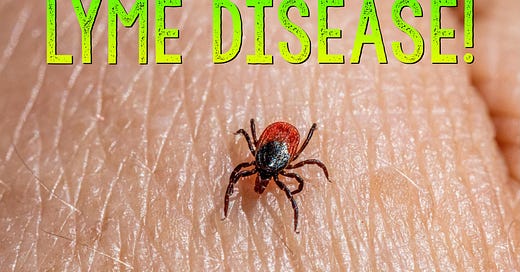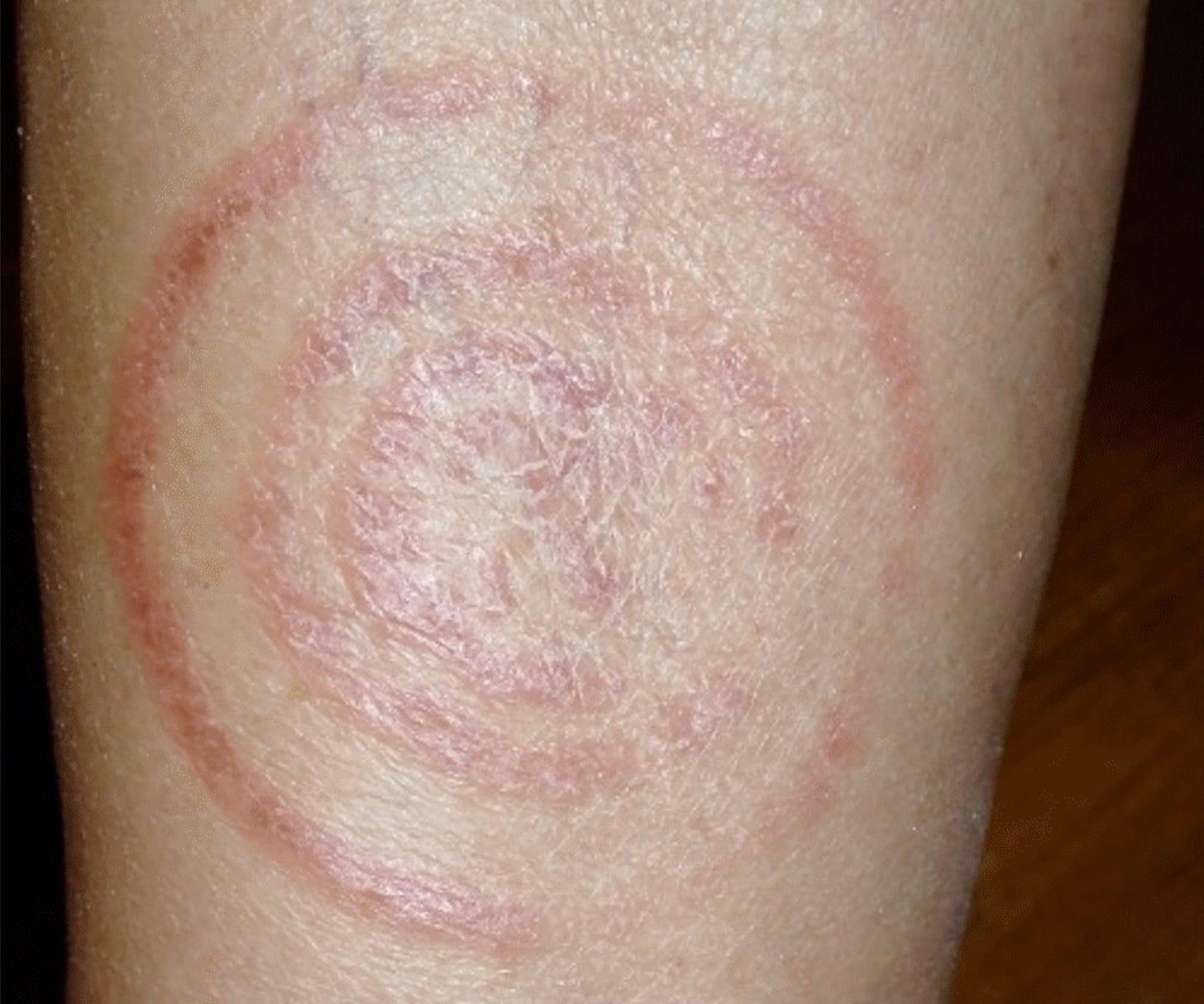Some diseases are easy to diagnose. A radiologist notices a spot on a mammogram, a biopsy is done, and a cancerous tumor is the culprit. A long-time smoker has trouble breathing, and lung disease is the unsurprising reason. A sedentary person who needs to lose weight is suddenly thirsty, tired, and hungry all the time, and when their blood sugar is tested, the result is Type 2 diabetes.
And then there’s Lyme Disease, transmitted through the bite of a tick infected with the Borrelia burgdorferi bacteria.
Simple, right? Get bitten, get symptoms, get treated, end of problem.
How I wish that it was that simple!
There’s nothing simple about Lyme. It is a multisystemic disease that has a broad range of symptoms that can be confused with many other diseases, including Chronic Fatigue Syndrome/Myalgic Encephalomyelitis, fibromyalgia, long Covid, autoimmune diseases like Rheumatoid arthritis or multiple sclerosis, and even Alzheimer’s dementia.
Instead, it can be confounding, capricious, cruel, and if not properly diagnosed, chronic.
[Image by Alex Green from Pixels.com]
Here’s why Lyme Disease can become chronic:
Ticks are everywhere. Many people who get a tick bite don’t even know they were bitten. Recent scientific studies have shown that 14.5% of the world’s population has now been exposed to Lyme disease. That is, theoretically, one in seven people that you meet may be walking around with Lyme disease and not know it!
Ticks can carry more than one bacteria. (In fact, Lyme is actually a disease complex caused by a large family of spirochetal bacteria.) There are over 100 different strains of Lyme disease in the US, and 300 strains worldwide. Although not all of these bacteria are pathogenic, every few years we discover another Borrelia species that makes people sick. Most deer ticks are cesspools containing other bacteria too, like Anaplasma, relapsing fever Borrelia, malaria-type parasites like Babesia, Bartonella, as well as viruses like the Powassan virus. Between 10-16% of people living in highly endemic areas for Lyme disease have been exposed to this virus, which can cause a severe infection and inflammation of the central nervous system with a meningitis (inflammation of the covering surrounding the brain) and/or encephalitis (inflammation of the brain). One tick bite, or multiple tick bites over time, can potentially inject multiple infectious agents into your body, further confusing the clinical picture and worsening your symptoms.
Different types of rashes can develop—not just the distinctive bullseye-like rash (called an EM, or Erythema migrans rash). Exposure to a Borrelia species can also cause a solid spreading rash, a violaceous rash of the hands and/or feet, hard reddish nodules on earlobes and different parts of the body, flat or macular raised rashes, and even a spotted, spreading rash. The problem is that less than 50 percent of cases lead to a rash—and even if you do get one, it can be located somewhere on your body where it’s difficult to see. (Also, know that spreading rashes can easily be confused with a cellulitis, and some rashes have small vesicles in the center that can be confused with a herpes zoster, or shingles-type rash.)
Much more on rashes in upcoming posts!
[Image courtesy of: Schotthoefer AM, Green CB, Dempsey G, Horn EJ. The Spectrum of Erythema Migrans in Early Lyme Disease: Can We Improve Its Recognition? Cureus. 2022 Oct 25;14(10):e30673. doi: 10.7759/cureus.30673. PMID: 36439577; PMCID: PMC9687974.]
Symptoms may not appear immediately, as EM rashes may take between 3 and 30 days after a tick bite to develop. In some cases, they may take longer. If your doctor gave you antibiotics for an unrelated infection while Borrelia was brewing in your body, it will also confuse the clinical picture as it will impair antibody production, making Lyme tests even more unreliable, while creating milder symptoms that can be confused with the “aches and pains of daily living” (a term used by some infectious disease doctors who don’t believe in Borrelia’s ability to persist).
Because there are so many types of Borrelia bacteria, testing is often not accurate. If your doctor uses a commercial laboratory that only checks for one strain, resulting in false negatives, this will lead those who are infected to think they’re okay…when they’re not.
With so much inaccurate testing, and Borrelia causing a broad range of symptoms, it’s really easy to misdiagnose Lyme. Remember, it’s a great imitator, similar to its spirochetal cousin syphilis. As I mentioned already, Lyme symptoms are often similar to those of many other diseases. This is why you need several tricks a true Medical Detective can use to sleuth out the presence of this stealth pathogen.
The standard short course of antibiotic treatment often doesn’t work if you’ve had the disease for more than a few months. This is because the bacteria knows how to hide in the body, evading your immune system, and can go dormant, relapsing later on when antibiotics have been stopped.
Many medical professionals are still woefully ignorant about Lyme treatment. Some of this is because of conflicting guidelines between professional organizations like the Infectious Disease Society of America (IDSA) and International Lyme and Associated Diseases Society (ILADS). The IDSA claims that Lyme disease is easy to diagnose and easy to cure, and if you have ongoing symptoms after a month of antibiotics, you have “Post Treatment Lyme Disease Syndrome” (PTLDS). The IDSA does not offer clinical guidance for PTLDS, leaving many people without guidance, forced to accept their chronic illness. ILADS guidelines, on the other hand, state that Lyme can be difficult to diagnose and treat, and that an infection with Borrelia can be chronic and relapsing, exacerbated by other infections or underlying medical problems.
Finally, Lyme disease is a political disease, not just a medical one, which makes it even more difficult for you to find a doctor willing to treat you if you are chronically ill. Healthcare practitioners have been attacked by medical licensing boards across the country because insurance companies have adopted the conservative IDSA guidelines. Many doctors have lost their licenses or had their practice restricted because of highly dysfunctional politics at the level of state medical boards, based on bias, economic interests of insurers who influence them, and difficulty of healthcare agencies to keep up with the rapidly emerging science.
Coming up next – what you need to know about Lyme symptoms.
If you want more information now, the lymediseaseassociation.org website is extremely helpful and easy to navigate. So is www.ILADS.org, the organization that I helped establish over 20 years ago.







